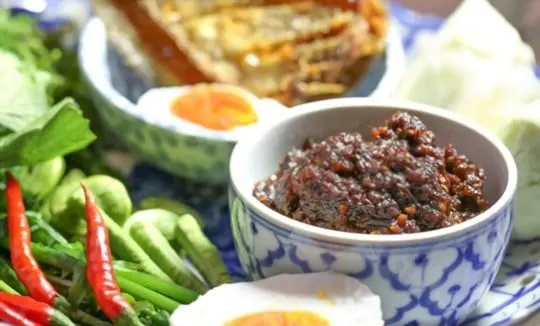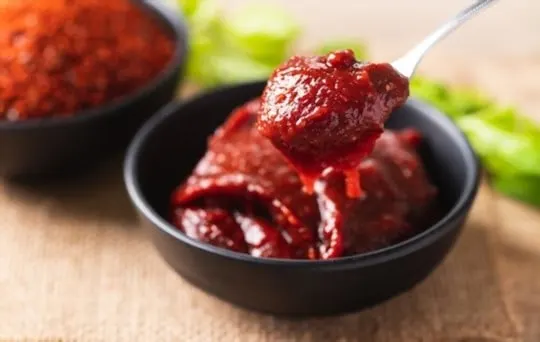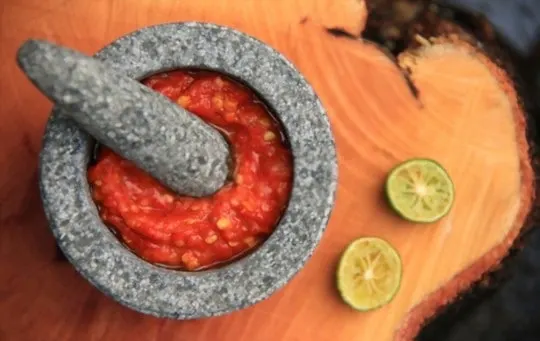Craving Thai food but stumbling over a missing Nam Prik Pao in your pantry?
Relax, we’ve all been there. This chili paste is a staple in Thai cooking, known for its robust flavor that can turn any dish from meh to wow.
But life’s too short to dash to the store every time a craving hits. Lucky for you, we’ve hacked the system.
We’re dishing out the five best stand-ins for Nam Prik Pao that you likely already have chilling in your kitchen.
No more mealtime meltdowns; welcome to your flavor rescue squad.

The 5 BEST Substitutes for Nam Prik Pao
If you’re looking for a spicy and flavorful condiment that can add a unique and delicious kick to your dishes, look no further than Nam Prik Pao.
But if you’re unable to find it or want to try something a bit different, there are plenty of substitutes that can provide the same level of kick while also offering their own distinctive flavor.
Here are five of the best Nam Prik Pao substitutions to consider:
1 – Make Your Own Nam Prik Pao

Nam prik pao is a flavorful Thai condiment that can liven up any meal.
Rich and aromatic, it has a delectable composition that combines the sweetness of palm sugar with the sourness of tamarind, together with the heat of chili peppers and the salty umami of shrimp paste.
The result is a delightfully complex mix of flavors that tantalizes the taste buds.
To make your own, start by roasting dried chilis and pounding them in a mortar and pestle along with shallots, garlic, lemon zest, and fish sauce; then add roasted peanuts, tamarind paste, and palm sugar to create a smooth texture you can adjust to your preferred spiciness level.
You’ll be sure to love this zesty addition to all your home-cooked meals.
2 – Sambal Terasi

Sambal Terasi is a type of condiment that can be found in many Southeast Asian dishes.
It is made from ground chili peppers combined with various other spices and shrimp paste, giving it a deep and complex flavor.
The texture is similar to that of Nam Prik Pao but has added spiciness and smokiness thanks to the shrimp paste.
For those looking for an easy substitute for Nam Prik Pao, Sambal Terasi provides an excellent option – just be mindful of the increased heat level.
All you have to do is adjust your recipe accordingly by using less or none at all if desired.
3 – Gochujang

Gochujang is a vibrant, spicy-sweet condiment originating from Korea.
Typically made by fermenting red chili peppers, sweet rice, and salt, this condiment has risen to popularity as one of the key seasonings in many Asian cuisines.
Its texture is smooth and silky, with a savory-sweet kick that hits all the right notes.
For those who love an added extra oomph to their food, gochujang is definitely worth a try.
In comparison to the good old Nam Prik Pao, the flavor profile is the perfect substitute since they both offer the same heat with salty back notes and slight sweetness.
Gochujang can be easily added to dishes such as noodles, marinades, or dressing for a deep umami flavor boost – with far less mess.
4 – Sambal Oelek

Sambal Oelek adds a kick of spice to any meal.
This chili sauce originated in Indonesia and has spread throughout the entire continent of Asia.
It has tons of flavor but not too much heat – just enough to bring out the delicious taste of whatever dish it is added to.
Sambal Oelek is made from ground red peppers, vinegar, and salt, so it has a complex yet well-balanced flavor that combines both pockets of heat with acidity.
Texturally, it is thick and chunky, so it adds a nice layer of texture to any dish.
If you’re looking for an alternative to the Thai Nam Prik Pao spread, consider substituting Sambal Oelek as a great way to boost the flavor of your meals.
5 – Chili Garlic Sauce

Chili garlic sauce is a delicious condiment with a variety of uses.
It’s made mainly from garlic and chili peppers, with salt, oil, and other seasonings often added to give it more depth of flavor.
As spicy as it can be, it’s still rounded out by the rich sweetness of roasted garlic.
Its texture is thick but spreadable, and long known for its ability to remain potent even after being heated.
Chili garlic sauce can make any dish pop — use it to spice up noodles or fried rice dishes or as a dipping sauce for sausage or grilled vegetables.
It can also be used in place of traditional Nam Prik Pao in your favorite Thai recipes for an extra kick.

Leave a comment